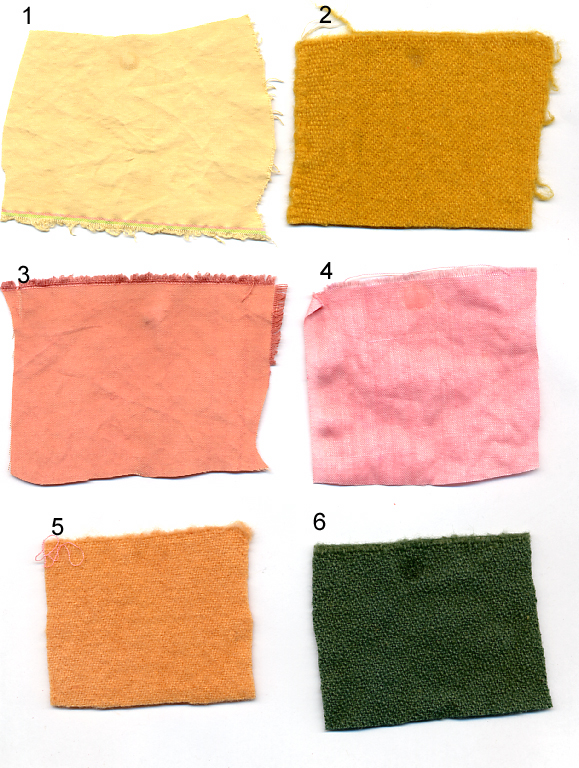
Ingredients
4 oz saffron
7 oz silk broadcloth fabric
1 oz handkerchief linen fabric
1 gal 13 ph lye (Red Devil)
1 cup lime juice
Process:
Put saffron in a bag, soak it for 8 hours in tepid water, and squeeze. Save the yellow dye that is expressed.
Once no more yellow dye comes out, dump the petals into an enamel bowl with 1 gallon of 13 ph lye. Let it sit for 5 hours, stirring every half hour.
Boil 5 gal water, 2 oz alum, .5 oz tartar. Add wetted silk & stir. Boil for an hour. (Also put in a swatch of wool, and a bit of the linen.)
Rinse silk.
Bring yellow dye to a boil. Add the silk & wool. Boil for an hour. The wool turned a respectable mustard yellow. The silk was a golden yellow when wet, and a light yellow once dry.very, very light yellow. After 5 hours, strain lye. It's a dusky orangish brown. Add 1 cup of lime juice. This turns the dye redder. Add 1 gal water, Add linen (unmordanted) and silk (with alum & tartar mordant.) The linen immediately turned a bright candy pink. The silk turned a duller flesh colour. The wool was duller still.
Keep it at around 120 for three hours, stirring every 15 minutes. Then turn off the heat and leave the dye overnight.
Notes: Alum had no discernable effect on the linen. It came out a light, bright, almost neon pink. The silk came out a lovely flesh color. The wool swatch came out a dull flesh color. Apparently, cellulose fibers pick up the red dye much better than protein based fibers...or else they don't pick up the yellow dye as much as silk & linen.
I based this recipe upon recipes for safflower dyeing in the Profitable Book (1580), Whole Art of Dying (1705), and Family Dyer and Scourer (1830). All recipes specified soaking the yellow dye out of the flowers and then extracting the red dye by either mixing the flowers with ashes and running water through to create a lye, or by soaking the flowers themselves in prepared lye. I went the prepared lye route for convenience's sake.
The colors were lighter than I would have liked. I used 4 oz of safflower to 4 oz of fabric, and ended up with two gallons of dye liquor. The Whole Art of Dying said "to every Pound of Silk take four Pound of Wild Saffron", while the Profitable book said "For every Pound of Ware take two Ounces of Bastard or Wild Saffron." The Dyer and Scourer notes that " that the liquor may not be too weak, three pounds of good safflower need not yield above half a pail full of deep red dye." So I think I may have used too much lye & water. This may be why the majority of recipes specify sprinkling ashes & safflower with water to create a lye--to get the strongest lye possible with the least amount of water.
Next time: double the proportion of safflower, halve the proportion of lye used. Also, experiment with mixing with ashes & precipitating lye from the mixture. Also, this creates a much nicer color on linen; stick with linen & with silk thread next time around.
Samples:
1. Yellow dye on silk.
2. Yellow dye on wool.
3. Red dye on silk.
4. Red dye on linen.
5. Red dye on wool.
6. Red dye on dark indigo wool.
